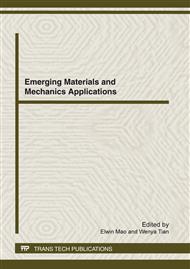p.653
p.658
p.663
p.668
p.672
p.677
p.682
p.687
p.692
Reduction of SSI by Hydrogen and its Microscopic Morphology
Abstract:
Spherical sponge iron (SSI) with high activity and intension possesses potential characteristics to be utilized as wastewater treatment material, such as higher iron content, uniform particle size, higher compressive strength, etc. Observation on apparent morphology of exterior and microscopic morphology of SSI reduced by hydrogen under different temperature was carried on with SEM. When the reductive temperature was relatively lower than T4, the quantities of iron grain in exterior and interior of SSI increased with the increasing of temperature. When the temperature was elevated to T5, the particle size of iron grain was increased, and lots of macro-holes formed, especially in the interior section of SSI. When the temperature was T4, the SSI possesses more favorable ability to remove pollutant from wastewater. Moreover, the iron content in SSI was mostly reach to the summit under this temperature. In summarization, the reduction temperature should be controlled under T4 temperature if the sponge iron was utilized in wastewater treatment.
Info:
Periodical:
Pages:
672-676
Citation:
Online since:
March 2012
Authors:
Price:
Сopyright:
© 2012 Trans Tech Publications Ltd. All Rights Reserved
Share:
Citation:


